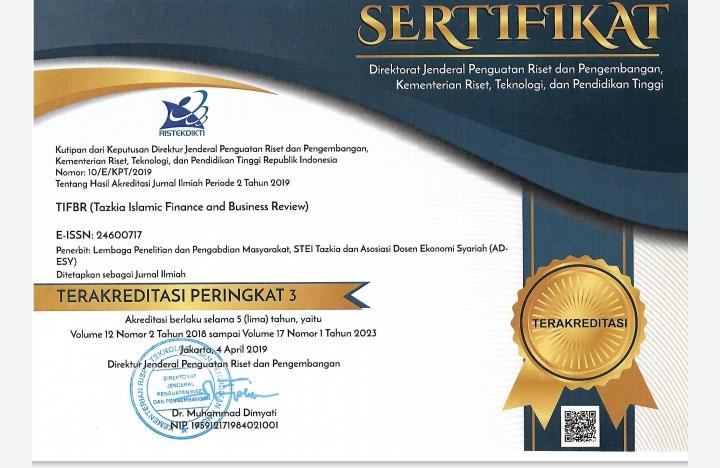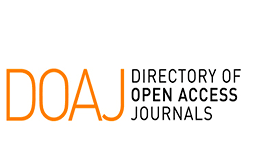Customer Satisfaction with Islamic Banks: A Case Study of Al Rajhi Bank
DOI:
https://doi.org/10.30993/tifbr.v11i1.119Keywords:
Customer Satisfaction, Banking Sector, Response, Saudi ArabiaAbstract
Abstract. This study aims to identify the factors that lead to the level of customer satisfaction about online services provided by Al Rajhi Bank, which is the largest Islamic Bank in the world. This study is conducted on a sample of customers who deal with Al Rajhi Bank in Qassim region, Saudi Arabia by measuring different constructs such as; reliability, efficiency, response, and empathy which have been taken as determinants of customer satisfaction. The sample size of the respondents is 184 clients. The study reveals that reliability, efficiency, response and empathy all have a positive and significant impact on customer satisfaction. In addition, the results also show that the dimension “efficiency” plays a leading role in the customer satisfaction. This means that indicators of efficiency like ease of service, diversity of online services, organized information and transactions in reasonable times frame are the most important factors in achieving customer satisfaction.
References
Al Karim, R. and Chowdhury, T. (2014). Customer Satisfaction on Service Quality in Private Commercial Banking Sector in Bangladesh. British Journal of Marketing Studies, Vol. 2(2): 1-11.
Alam, D. (2012). Measurement of Customer Satisfaction of Internet Banking Service; an Analytical Study with Special Reference to Selected Customers and Banks in Gujarat. Indian Journal of Research, Vol. 1(2): 120-123.
Aljasser, I. and Sasidhar, B. (2015). Satisfaction Perceptions Differences of Customers of Banks in Saudi Arabia Based on Gender. British Journal of Economics, Management & Trade, Vol. 7(4): 279-287.
Almotairi, M., Almeshal, S. and Alam, A. (2013). Online Service Quality and Customers’ Satisfaction: A Case Study of The Selected Commercial Banks in Riyadh (Saudi Arabia). Pensee Journal, Vol. 75(12): 190-197.
Ankit, S. (2011). Factors Influencing Online Banking Customer Satisfaction and Their Importance in Improving Overall Retention Levels: An Indian Banking Perspective. Journal of Information and Knowledge Management, Vol. 1(1): 45-55.
Boone H. and Boone D. (2012). Analyzing The Likert Data. The Journal of Extension, Vol. 50(2).
Creswell, J. W. (2009). Research Design, Qualitative, Quantitative and Mixed Method Approaches. Sage Publication.
Dahlinger, A. and Yassaee, M. (2014). What Types of Research Designs Exist? 1st ed. University of St. Gallen.
Federalreserve.gov. (2015). FRB: Speech, Ferguson -- Information Technology in Banking and Supervision -- October 20, 2000. Available at: http://www.federalreserve.gov/boarddocs/speeches/2000/20001020.htm.
George, A, and Kumar, A. (2014). Impact of Service Quality Dimensions in Internet Banking on Customer Satisfaction. Indian Institute of Management Calcutta, Vol. 41(1): 73–85.
Hasan, M. (2015). Online & Internet Banking & its Effect on Customer Satisfaction. Master’s Thesis.
Ibok, N. and Ikoh, I. (2013). Determinants of Customers Satisfaction with Internet Banking Services. British Journal of Arts and Social Sciences, Vol. 14(2): 178-185
Ling, G. et al. (2016). Understanding Customer Satisfaction of Internet Banking: A Case Study in Malacca. Procedia Economics and Finance, Vol. 37: 80-85.
Musiime, A. and Ramadhan, M. (2011). Internet Banking, Consumer Adoption and Customer Satisfaction. African Journal of Marketing Management, Vol. 3(10): 261-269.
Nimako, S.G., Gyamfi, N.K. and Wandaogou, A. (2013). Customer Satisfaction with Internet Banking Service Quality in The Ghanaian Banking Industry. International Journal Of Scientific & Technology Research, Vol. 2(7): 165-175.
Nochai, R. and Nochai, T. (2013). The Impact of Internet Banking Service on Customer Satisfaction in Thailand: A Case Study in Bangkok. International Journal of Humanities and Management Sciences (IJHMS), Vol. 1(1): 101-105.
PWC. (2014). What Customers Want: Customer Insights to Inform Growth Strategies of Islamic Banks in the Middle East. Middle East Islamic Finance Survey. October. Retrieved from: https://www.pwc.com/m1/en/publications/middle_east_islamic_finance_survey.pdf
Qureshi, T.M. and Zalar, M.K. (2008). Customer Acceptance of Online Banking in Developing Economies. Journal of Marketing Research, Vol. 7(4): 184-189.
Rajpara, Y. and Mistry, K. (2012). Level of Customer Satisfaction While Using Internet Banking: A Study of Anand City. International Journal of Marketing & Business Communication, Vol. 1(3): 58-65.
Rashidi, E. and Mansoori, E. (2015). Discussing The Effects of Internet Banking on Customer Satisfaction. Indian Journal of Fundamental and Applied Life Sciences, Vol. 5(S2): 182-187.
Raza, S.A., Jawaid, S.T. and Hasan, A. (2015). Internet Banking and Customer Satisfaction in Pakistan. Qualitative Research in Financial Markets, Vol. 7(1): 24-36
Rod, M., Ashill, N., Shao, J., and Carruthers, J. (2008). An Examination of the Relationship between Service Quality Dimensions, Overall Internet Banking Service Quality and Customer Satisfaction: A New Zealand Study. Marketing Intelligence & Planning, Vol. 27(1): 103-104.
Sakhaei, F., Afshari, A. and Esmaili, E. (2013). The Impact of Service Quality on Customer Satisfaction in Internet Banking. Journal of Mathematics and Computer Science, Vol. 9: 33-40.
Sanjuq, G. (2014). The Impact of Service Quality Delivery on Customer Satisfaction in The Banking Sector in Riyadh, Saudi Arabia. International Journal of Business Administration, Vol. 5(4): 77-83
Sekaran, U. and Bougie, R. (2013). Research Methods for Business: A Skill Building Approach. 6th Edition, New York: John Wiley and Sons.
Downloads
Published
Versions
- 2023-01-12 (2)
- 2018-04-01 (1)
How to Cite
Issue
Section
License
Copyright (c) 2018 Author and Publisher

This work is licensed under a Creative Commons Attribution-NonCommercial-ShareAlike 4.0 International License.

Tazkia Islamic Finance and Business Review (TIFBR) is licensed under a Creative Commons Attribution-NonCommercial 4.0 International License.
Authors who publish with this journal agree to the following terms:
- Authors retain copyright and grant the journal right of first publication with the work simultaneously licensed under a Creative Commons Attribution License that allows others to share the work with an acknowledgment of the work's authorship and initial publication in this journal.
- Authors are able to enter into separate, additional contractual arrangements for the non-exclusive distribution of the journal's published version of the work (e.g., post it to an institutional repository or publish it in a book), with an acknowledgment of its initial publication in this journal.
- Authors are permitted and encouraged to post their work online (e.g., in institutional repositories or on their website), as it can lead to productive exchanges, as well as earlier and greater citation of published work (See the Effect of Open Access).
















